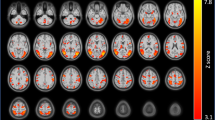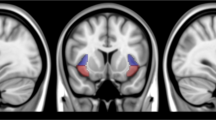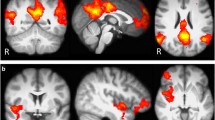Abstract
Negative urgency, defined as a tendency to act rashly under extreme negative emotion, is strongly associated with tobacco use. Despite the robust evidence linking negative urgency and tobacco use and accumulating evidence suggesting that localized, segregated brain regions such as the nucleus accumbens (NAcc), insula, and amygdala are related to negative urgency, resting state functional connectivity (rsFC) of negative urgency in tobacco use has not yet been examined. This study included 34 daily tobacco users and 62 non-users matched on age, gender, race/ethnicity, and lifetime psychiatric diagnosis from a publicly available neuroimaging dataset collected by the Nathan Kline Institute-Rockland Project. Using the bilateral NAcc, insula, and amygdala as seed regions, seed-based rsFC analyses were conducted on the whole brain. In the whole sample, negative urgency was positively correlated with rsFC between the left insula and right dorsal anterior cingulate cortex (dACC). Compared to non-users, tobacco users had a stronger rsFC strength between the right amygdala and right middle temporal gyrus. In tobacco users, negative urgency was negatively associated with rsFC between the left NAcc and right dACC and between the left NAcc and right dorsolateral prefrontal cortex; these relationships were positive in non-users. Identifying functional connectivity implicated in negative urgency and tobacco use is the crucial first step to design and test pharmacological and physiological interventions to reduce negative urgency related tobacco use.



Similar content being viewed by others
References
Albein-Urios, N., Verdejo-Román, J., Asensio, S., Soriano-Mas, C., Martínez-González, J. M., & Verdejo-García, A. (2012). Re-appraisal of negative emotions in cocaine dependence: Dysfunctional corticolimbic activation and connectivity. Addiction Biology, 19, 415–426. https://doi.org/10.1111/j.1369-1600.2012.00497.x.
Albein-Urios, N., Verdejo-Román, J., Soriano-Mas, C., Asensio, S., Martínez-González, J. M., & Verdejo-García, A. (2013). Cocaine users with comorbid cluster B personality disorders show dysfunctional brain activation and connectivity in the emotional regulation networks during negative emotion maintenance and reappraisal. European Neuropsychopharmacology, 23, 1698–1707. https://doi.org/10.1016/j.euroneuro.2013.04.012.
Billieux, J., Van der Linden, M., & Ceschi, G. (2007). Which dimensions of impulsivity are related to cigarette craving? Addictive Behaviors, 32(6), 1189–1199. https://doi.org/10.1016/j.addbeh.2006.08.007.
Biswal, B. B., Yetkin, F. Z., Haughton, V. M., & Hyde, J. S. (1995). Functional connectivity in the motor cortex of resting human brain using echo-planar MRI. Magnetic Resonance in Medicine, 34(9), 537–541. https://doi.org/10.1002/mrm.1910340409.
Biswal, B. B., Van Kylen, J., & Hyde, J. S. (1997). Simultaneous assessment of flow and BOLD signals in resting-state functional connectivity maps. NMR in Biomedicine, 10, 165–170. https://doi.org/10.1002/(SICI)1099-1492(199706/08)10.
Brody, A. L. (2006). Functional brain imaging of tobacco use and dependence. Journal of Psychiatric Research, 40, 404–418. https://doi.org/10.1016/j.jpsychires.2005.04.012.
Buckner, R. L. (2010). Human functional connectivity: New tools, unresolved questions. PNAS, 107(24), 10769–10770. https://doi.org/10.1073/pnas.1005987107.
Bush, G., Luu, P., & Posner, M. I. (2000). Cognitive and emotional influences in anterior cingulate cortex. Trends in Cognitive Sciences, 4(6), 215–222.
Cabeza, R., & Nyberg, L. (2000). Imaging cognition II: An empirical review of 275 PET and fMRI studies. Journal of Cognitive Neuroscience, 12(1), 1–47. https://doi.org/10.1162/08989290051137585.
Chao, L. L., Haxby, J. V., & Martin, A. (1999). Attribute-based neural substrates in temporal cortex for perceiving and knowing about objects. Nature Neuroscience, 2(10), 913–919. https://doi.org/10.1038/13217.
Chester, D. S., Lynam, D. R., Milich, R., Powell, D. K., Andersen, A. H., & DeWall, C. N. (2016). How do negative emotions impair self-control? A neural model of negative urgency. NeuroImage, 132, 43–50. https://doi.org/10.1016/j.neuroimage.2016.02.024.
Chou, S. P., Goldstein, R. B., Smith, S. M., Huang, B., Ruan, W. J., Zhang, H., Jung, J., Saha, T. D., Pickering, R. P., & Grant, B. F. (2016). The epidemiology of DSM-5 nicotine use disorder: Results from the National Epidemiologic Survey on alcohol and related Conditons-III. Journal of Clinical Psychiatry, 77(10), 1404–1412. https://doi.org/10.4088/JCP.15m10114.
Contreras-Rodríguez, O., Albein-Urios, N., Vilar-López, R., Perales, J. C., Martínez-Gonzalez, J. M., Fernández-Serrano, M. J., Lozano-Rojas, O., Clark, L., & Verdejo-García, A. (2015). Increased corticolimbic connectivity in cocaine dependence versus pathological gambling is associated with drug severity and emotion-related impulsivity. Addiction Biology, 21, 1–10. https://doi.org/10.1111/adb.12242.
Coskunpinar, A., Dir, A. L., & Cyders, M. a. (2013). Multidimensionality in impulsivity and alcohol use: A meta-analysis using the UPPS model of impulsivity. Alcoholism: Clinical and Experimental Research, 37(9), 1441–1450. https://doi.org/10.1111/acer.12131.
Cox, R. W. (1996). AFNI: Software for analysis and visualization of functional magnetic resonance neuroimages. Computers and Biomedical Research, 29(3), 162–173. https://doi.org/10.1006/cbmr.1996.0014.
Cyders, M. A., & Smith, G. T. (2007). Mood-based rash action and its components: Positive and negative urgency. Personality and Individual Differences, 43, 839–850.
Cyders, M. A., & Smith, G. T. (2008). Emotion-based dispositions to rash action: Positive and negative urgency. Psychological Bulletin, 134(6), 807–828. https://doi.org/10.1037/a0013341.
Cyders, M. A., & Coskunpinar, A. (2010). Is urgency emotionality? Separating urgent behaviors from effects of emotional experiences. Personality and Individual Differences, 48(7), 839–844. https://doi.org/10.1016/j.paid.2010.02.009.
Cyders, M. A., Dzemidzic, M., Eiler, W. J., Coskunpinar, A., Karyadi, K., & Kareken, D. A. (2014). Negative urgency and ventromedial prefrontal cortex responses to alcohol cues: FMRI evidence of emotion-based impulsivity. Alcoholism, Clinical and Experimental Research, 38(2), 409–417. https://doi.org/10.1111/acer.12266.
Cyders, M. A., Dzemidzic, M., Eiler, W. J., Coskunpinar, A., Karyadi, K. A., & Kareken, D. A. (2015). Negative urgency mediates the relationship between amygdala and orbitofrontal cortex activation to negative emotional stimuli and general risk-taking. Cerebral Cortex, 25, 4094–4102. https://doi.org/10.1093/cercor/bhu123.
Destrieux, C., Fischl, B., Dale, A., & Halgren, E. (2010). Automatic parcellation of human cortical gyri and sulci using standard anatomical nomenclature. NeuroImage, 53(1), 1–15. https://doi.org/10.1016/j.neuroimage.2010.06.010.
Doran, N., Cook, J., McChargue, D., Myers, M., & Spring, B. (2008). Cue-elicited negative affect in impulsive smokers. Psychology of Addictive Behaviors, 22(2), 249–256. https://doi.org/10.1037/0893-164X.22.2.249.
Doran, N., Cook, J., McChargue, D., & Spring, B. (2009). Impulsivity and cigarette craving: Differences across subtypes. Psychopharmacology, 207(3), 365–373. https://doi.org/10.1007/s00213-009-1661-x.
Goldstein, R. Z., & Volkow, N. D. (2012). Dysfunction of the prefrontal cortex in addiction: Neuroimaging findings and clinical implications. Nature Review Neuroscience, 12(11), 652–669. https://doi.org/10.1038/nrn3119.Dysfunction.
Heatherton, T. F., Kozlowski, L. T., Frecker, R. C., & Fagerström, K. O. (1991). The Fagerström test for nicotine dependence: A revision of the Fagerström tolerance questionnaire. British Journal of Addiction, 86(9), 1119–1127. https://doi.org/10.1111/j.1360-0443.1991.tb01879.x.
Hoptman, M. J., Antonius, D., Mauro, C. J., Parker, E. M., & Javitt, D. C. (2014). Cortical thinning, functional connectivity, and mood-related impulsivity in schizophrenia: Relationship to aggressive attitudes and behavior. American Journal of Psychiatry, 171(9), 939–948. https://doi.org/10.1176/appi.ajp.2014.13111553.
Janes, A. C., Pizzagalli, D. A., Richardt, S., Frederick, B. d. B., Chuzi, S., Pachas, G., et al. (2010). Brain reactivity to smoking cues prior to smoking cessation predicts ability to maintain tobacco abstinence. Biological Psychiatry, 67(8), 722–729. https://doi.org/10.1016/j.biopsych.2009.12.034.
Jo, H. J., Saad, Z. S., Simmons, W. K., Milbury, L. A., & Cox, R. W. (2010). Mapping sources of correlation in resting state FMRI, with artifact detection and removal. NeuroImage, 52(2), 571–582. https://doi.org/10.1016/j.neuroimage.2010.04.246.
Kühn, S., & Gallinat, J. (2011). Common biology of craving across legal and illegal drugs - a quantitative meta-analysis of cue-reactivity brain response. European Journal of Neuroscience, 33(7), 1318–1326. https://doi.org/10.1111/j.1460-9568.2010.07590.x.
LeDoux, J. (2007). The amygdala. Current Biology, 17(20), R868–R874.
Lee, D. C., Peters, J. R., Adams, Z. W., Milich, R., & Lynam, D. R. (2015). Specific dimensions of impulsivity are differentially associated with daily and non-daily cigarette smoking in young adults. Addictive Behaviors, 46, 82–85. https://doi.org/10.1016/j.addbeh.2015.03.009.
Luijten, M., Veltman, D. J., Brink, d., van, W., Hester, R., Field, M., Smits, M., & Franken, I. H. A. (2011). Neurobiological substrate of smoking-related attentional bias. NeuroImage, 54(3), 2374–2381. https://doi.org/10.1016/j.neuroimage.2010.09.064.
Lynam, D. R., Smith, G. T., Whiteside, S. P., & Cyders, M. A. (2006). The UPPS-P: Asessing five personality pathways to impulsive behavior. West Lafayette: Purdue University.
MacDonald, A. W., Cohen, J. D., Stenger, V. A., & Carter, C. S. (2000). Dissociating the role of the dorsolateral prefrontal and anterior cingulate cortex in cognitive control. Science, 288(5472), 1835–1838. https://doi.org/10.1126/science.288.5472.1835.
Moeller, K. E., Lee, K. C., & Kissack, J. C. (2008). Urine drug screening: Practical guide for clinicians. Mayo Clinic Proceedings, 83(1), 66–76. https://doi.org/10.4065/83.1.66.
Mowinckel, A. M., Espeseth, T., & Westlye, L. T. (2012). Network-specific effects of age and in-scanner subject motion: A resting-state fMRI study of 238 healthy adults. NeuroImage, 63(3), 1364–1373. https://doi.org/10.1016/j.neuroimage.2012.08.004.
Muhlert, N., & Lawrence, A. D. (2015). Brain structure correlates of emotion-based rash impulsivity. NeuroImage, 115, 138–146. https://doi.org/10.1016/j.neuroimage.2015.04.061.
Nooner, K. B., Colcombe, S. J., Tobe, R. H., Mennes, M., Benedict, M. M., Moreno, A. L., et al. (2012). The NKI-Rockland sample: A model for accelerating the pace of discovery science in psychiatry. Frontiers in Neuroscience, 6(152), 1–11. https://doi.org/10.3389/fnins.2012.00152.
Richter, K. P., Kaur, H., Resnicow, K., Nazir, N., Mosier, M. C., & Ahluwalia, J. S. (2004). Cigarette smoking among marijuana users in the United States. Substance Abuse, 25(2), 35–43. https://doi.org/10.1300/J465v25n02_06.
Saad, Z. S., Gotts, S. J., Murphy, K., Chen, G., Jo, H. J., Martin, A., & Cox, R. W. (2012). Trouble at rest: How correlation patterns and group differences become distorted after global signal regression. Brain Connectivity, 2(1), 25–32. https://doi.org/10.1089/brain.2012.0080.
Satterthwaite, T. D., Elliott, M. A., Gerraty, R. T., Ruparel, K., Loughead, J., Calkins, M. E., et al. (2013). An improved framework for confound regression and filtering for control of motion artifact in the preprocessing of resting-state functional connectivity data. NeuroImage, 64(1), 240–256. https://doi.org/10.1016/j.neuroimage.2012.08.052.
Schauer, G. L., Berg, C. J., Kegler, M. C., Donovan, D. M., & Windle, M. (2015). Assessing the overlap between tobacco and marijuana: Trends in patterns of co-use of tobacco and marijuana in adults from 2003-2012. Addictive Behaviors, 49(2015), 26–32. https://doi.org/10.1016/j.addbeh.2015.05.012.
Schultz, W., Dayan, P., & Montague, P. R. (1997). A neural substrate of prediction and reward. Science, 275, 1593–1598.
Seeley, W. W., Menon, V., Schatzberg, A. F., Keller, J., Glover, G. H., Kenna, H., Reiss, A. L., & Greicius, M. D. (2007). Dissociable intrinsic connectivity networks for salience processing and executive control. Journal of Neuroscience, 27(9), 2349–2356. https://doi.org/10.1523/JNEUROSCI.5587-06.2007.
Settles, R. E., Fischer, S., Cyders, M. A., Combs, J. L., Gunn, R. L., & Smith, G. T. (2012). Negative urgency: A personality predictor of externalizing behavior characterized by neuroticism, low conscientiousness, and disagreeableness. Journal of Abnormal Psychology, 121(1), 160–172. https://doi.org/10.1037/a0024948.
Smith, G. T., & Cyders, M. A. (2016). Integrating affect and impulsivity: The role of positive and negative urgency in substance use risk. Drug and Alcohol Dependence, 163, S3–S12. https://doi.org/10.1016/j.drugalcdep.2015.08.038.
Spillane, N. S., Smith, G. T., & Kahler, C. W. (2010). Impulsivity-like traits and smoking behavior in college students. Addictive Behaviors, 35(7), 700–705. https://doi.org/10.1016/j.addbeh.2010.03.008.
Talairach, J., & Tournoux, P. (1988). Co-planar streotaxic atlas of the human brain. 3-dimensional proportional system: an approach to cerebral imaging. G. Thieme.
Uddin, L. Q., Nomi, J. S., Hébert-Seropian, B., Ghaziri, J., & Boucher, O. (2017). Structure and function of the human insula. Journal of Clinical Neurophysiology : Official Publication of the American Electroencephalographic Society, 34(4), 300–306. https://doi.org/10.1097/WNP.0000000000000377.
Volkow, N. D., Wang, G.-J., Fowler, J. S., Tomasi, D., & Telang, F. (2011). Addiction: Beyond dopamine reward circuitry. PNAS, 108(37), 15037–15042. https://doi.org/10.1073/pnas.1010654108.
Whiteside, S. P., & Lynam, D. R. (2001). The five factor model and impulsivity: Using a structural model of personality to understand impulsivity. Personality and Individual Differences, 30(4), 669–689. https://doi.org/10.1016/S0191-8869(00)00064-7.
Wilbertz, T., Deserno, L., Horstmann, A., Neumann, J., Villringer, A., Heinze, H. J., Boehler, C. N., & Schlagenhauf, F. (2014). Response inhibition and its relation to multidimensional impulsivity. NeuroImage, 103, 241–248. https://doi.org/10.1016/j.neuroimage.2014.09.021.
Zhang, X., Salmeron, B. J., Ross, T. J., Gu, H., Geng, X., Yang, Y., & Stein, E. A. (2011). Anatomical differences and network characteristics underlying smoking cue reactivity. NeuroImage, 54(1), 131–141. https://doi.org/10.1016/j.neuroimage.2010.07.063.
Zhu, X., Cortes, C. R., Mathur, K., Tomasi, D., & Momenan, R. (2015). Model-free functional connectivity and impulsivity correlates of alcohol dependence: A resting-state study. Addiction Biology, 22, 206–217. https://doi.org/10.1111/adb.12272.
Acknowledgements
The authors thank the Nathan Kline Institute for data sharing and Drs. Marian Logrip and Jesse Stewart for their helpful comments on an earlier draft of this manuscript. This project was based on an unpublished Master’s Thesis by the first author.
Funding
This study was funded by the National Institute on Alcoholism and Alcohol Abuse T32 grant (AA07462, PI: Czachowski) for Miji Um under the mentorship of Melissa A. Cyders and a K01 (K01AA020102, PI: Cyders). This work was also made possible through data sharing of the Rockland project by Nathan Kline Institute with support of several grants for data collection from the National Institutes of Health (NIMH BRAINS R01MH094639, PI: Milham, NIMH U01MH099059, PI: Milham; NIMH R01MH101555, PI: Craddock; NIA R01AG047596, PI: Colcombe). The listed funding agencies were not involved in study design, collection, analysis, and interpretation of the data. The opinions expressed in this manuscript are stated by the authors and do not reflect the views of listed funding agencies.
Author information
Authors and Affiliations
Corresponding author
Ethics declarations
Conflict of interest
The authors declare that they have no conflict of interest.
Ethical approval
This article contained analyses on de-identified data and thus was except from human subjects’ review.
Informed consent
Informed consent was obtained from all individual participants included in the study at the Nathan Kline Institute.
Additional information
Publisher’s note
Springer Nature remains neutral with regard to jurisdictional claims in published maps and institutional affiliations.
Rights and permissions
About this article
Cite this article
Um, M., Hummer, T.A. & Cyders, M.A. Relationship of negative urgency to cingulo-insular and cortico-striatal resting state functional connectivity in tobacco use. Brain Imaging and Behavior 14, 1921–1932 (2020). https://doi.org/10.1007/s11682-019-00136-1
Published:
Issue Date:
DOI: https://doi.org/10.1007/s11682-019-00136-1




